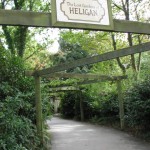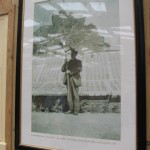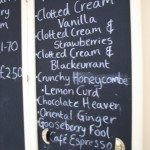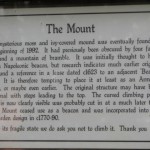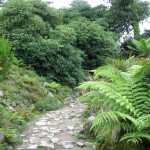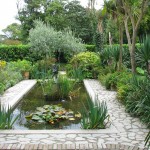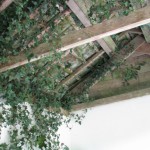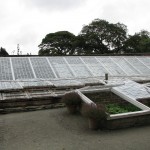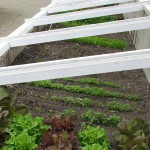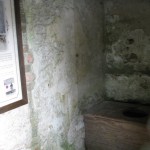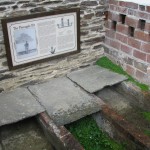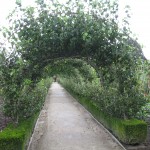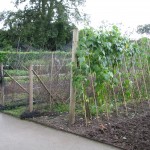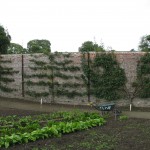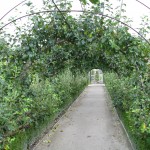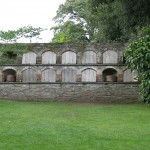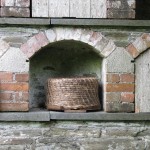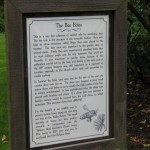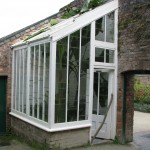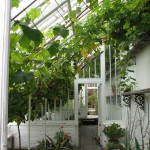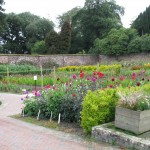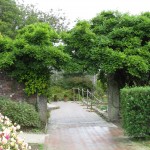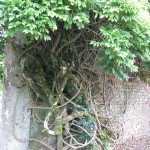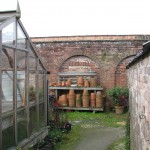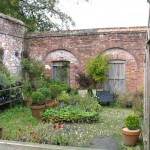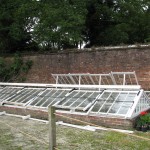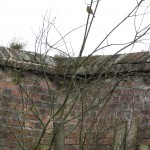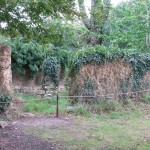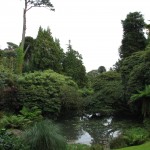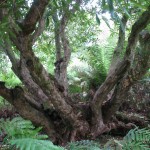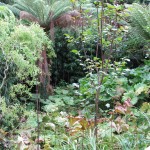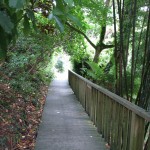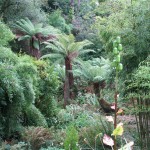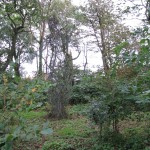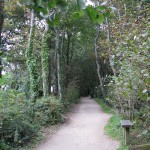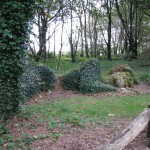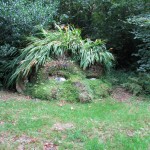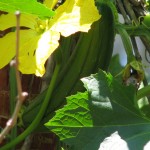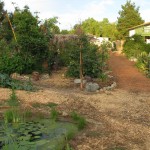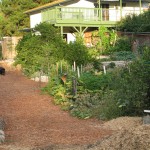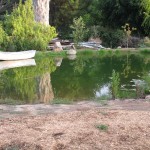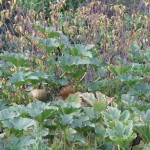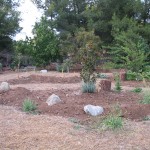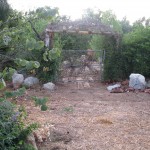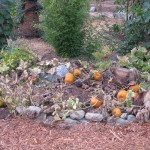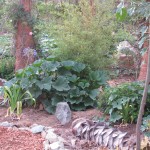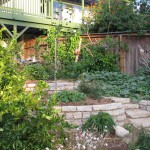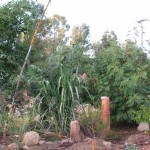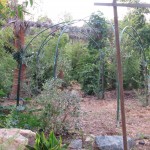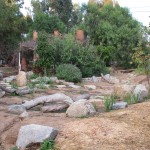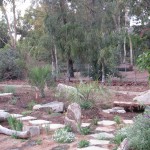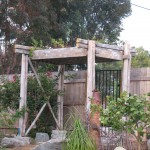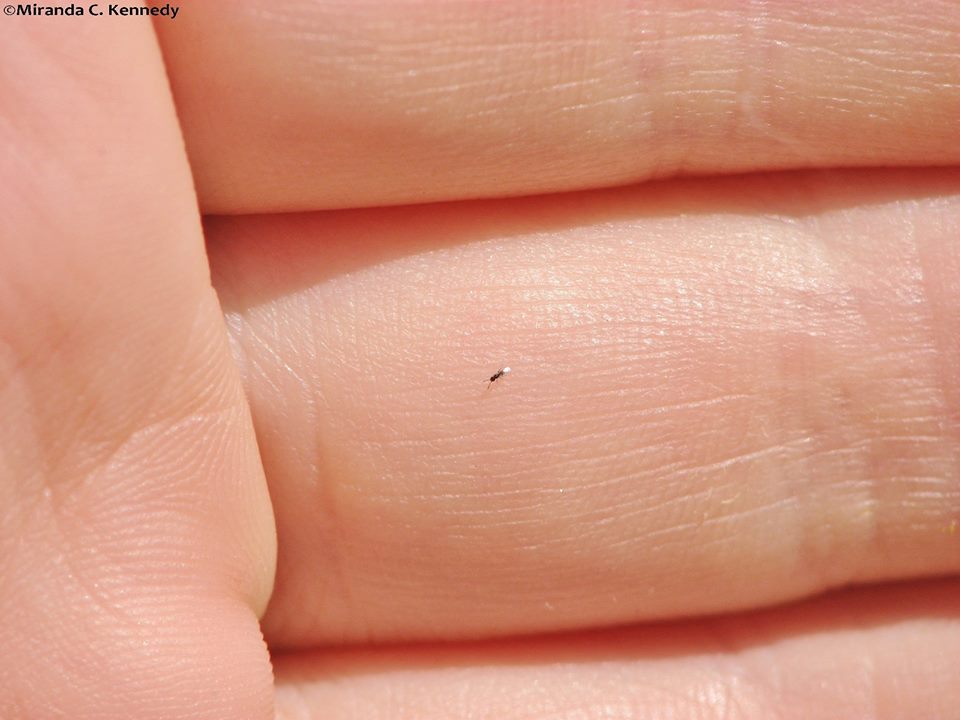-
The Lost Gardens of Heligan
If you ever go to England, go to Cornwall and spend at least a day at the Lost Gardens of Heligan (http://www.heligan.com/ ). Due to a flat tire we only spent four hours there and we didn’t see even half of the 400 acres of incredible restored gardens. The story is this: a thousand acres on the southern coast of Cornwall has belonged to the Tremayne family for about 400 years. At the end of the 1800’s, one of the Tremaynes had built extensive theme gardens. There were walled gardens, enormous hedges, glass houses, cold frames, a pineapple pit where the only pineapple grown in Cornwall grew warmed by horse manure. Melon houses, leisure gardens, formal flower gardens, woods, kitchen gardens and unbelievably, tropical gardens, filled the estate. Due to Cornwall’s position by the English Channel the climate is such that with care tropicals can be grown there. The estate was fantastic; then came WW I, and almost half the family and staff were killed. The gardens were abandoned. Subsequent wars and taxes took their toll, and the gardens became overgrown. Vines, brambles, trees and weeds ran rampant, breaking through the glass roofs, pulling apart brick walls, upsetting carefully laid pathways and covering every trace of the gardens under a head-high blanket of tangled, thorny brush.
Twenty-one years ago, the Tremayne who inheirited the gardens, asked one of the founders of the neighboring Eden Project ( http://www.edenproject.com/ ) to try and restore the gardens. The task was phenomenal and reads like a mystery. Hacking through the overgrowth they found the walls, the foundations and the clues as to what had been. Since then the gardens have been restored. They are everyone’s dream of a garden combined. There is a mound that was a beacon mound during Nepolianic times, but then discovered dates back to the Armada, and then back to Medieval times! There is a jungle with massive gunnera plants and palm trees, about half an acre of vegetables all grown from seed that dates from the late Victorian time, walled flower gardens, ‘antique’ poultry and cattle, unique sculptures recently added, and a wildlife garden to encourage the existence of so many insects, birds and animals that are disappearing. Even with weeding through photos I came up with so many that I want to share, that I’ll just post them below. Visit the website and read up on the Lost Gardens, voted Britain’s Finest Gardens. They are magical.
Entrance to a magical world. The Tremayne who built the gardens holding a single Gunnera leaf in front of his famous pineapple pit. Flavors of ice cream… we didn’t get to have any! A mysterious mound was uncovered and thought to have been a beacon site in Nepolianic times, and for centuries beyond that. Stone steps into the ravine The Italian garden Ivy coming through the roof, trying to reclaim the building once again. Hot houses and cold frames Cold frames for veg. Espaliered pears of many varieties. Writing on the wall of the ‘thunder room’, or original composting toilet All plants and veg grown are from the late Victorian period Espaliered fruit trees make use of warm wall space About a quarter acre of mixed greens. Bee skeps (baskets, pre-movable hives) were kept in boles for winter protection. A bee skep in a bee bole History of the Bee Boles A banana grows in Cornwall! Melon houses Potting shed with greenhouses in a walled area. Sigh. Cold frames in the potting shed A robin watches, just like in The Secret Garden The overgrown remains of mud brick walls A very steep pathway lined with chicken wire to prevent slipping The Jungle A wire sculpture of a woman with her arms out… can you see her? A deciduous walkway Mud Woman A very green man - Chickens, Gardening adventures, Heirloom Plants, Permaculture and Edible Forest Gardening Adventures, Photos, Ponds, Rain Catching, Vegetables, Vegetarian
The August Garden
Plants have been enjoying the beautiful weather and the constant irrigation from the well, and the garden is flourishing. So, unfortunately, is the Bermuda grass, but that is another tale. Since I see it everyday I don’t notice the change so much, but when I show someone around I am thrilled all over again with the incredible change that has happened on this property. There are so many birds, insects, reptiles and other animals either already here or scouting it out that I know the project is a success. It is a habitat, not just for me and my family, but for native flora and fauna as well. It wasn’t so long ago that I had a cracked, weedy asphalt driveway, a termite-ridden rickety porch that needed pest control, a house with a stinky deteriorating carpet and old splotchy paint, a tile kitchen counter with the grout gone in between and a cleaning nightmare, and a yard full of snails, weeds and Washingtonia palm trees, with the embankment eroding each rainfall. Over the last four years we’ve survived some pretty intense construction projects (none of which were done on time, no matter what they promised!). My house still has some repairs that need to be done but I no longer am embarrassed to have anyone over. The garden is wonderful to walk in and explore. I’ve taken some photos this evening to show you how things are growing:
Bees enjoying purple coneflowers The luffa squash has mighty asperations. A luffa squash and bloom. They are edible small and green, but I’ll leave them to dry. Five eggs today! Each laying hen participated for the first time! The little girls have grown up. The small lower pond and the palm pathway. The veggie bed. Rushes, fleabane, waterlilies and other plants are growing in nicely around the big pond. The boat is still on loan from Aquascape. A pumpkin tree? This apricot isn’t healthy, but the pumpkins sure are. These bare areas I’ll fill with plants that will make up guilds, each plant filling a niche to help the others grow. The entrance to the bee garden. Native vinegar weed loves a place we left untouched, and so do the bees. Sugar pumpkins ready a little early for Halloween. A feral zucchini, still producing at least one a day. Melons, passionfruit, pitcher plant and many others under the back porch we call the Poop Deck. Very eager bamboo, sugarcane and hops. Olive trees tied to painted PVC pipe to make a hut. The ‘Nest’ beyond the dry stream bed. A thud and a swish… with no warning the neighbor’s tree fell across the fence. A green roof for the entranceway, just beginning to show. The watermelons in the vegetable beds were tiny… these monsters are wild. That one grew on the rock on its own. Entranceway flower tunnel… with dogs waiting to go inside! -
Dutchman’s Pipe

Vigorous Vines There are a few very peculiar specimens in my garden, thanks to Roger Boddaert. They have nothing to do with edible forest gardens, drought tolerant plants or permaculture. They simply are fun. One of which is the Dutchman’s Pipe (Aristolochia), named that because it’s very odd buds look something like… well… the pipe a Dutchman might smoke, I’m guessing. I’m thinking that the Dutchman was either blind or drinking heavily to put something that looked like this in his mouth! Another less imaginative name for this variety is Calico Flower. They look like hanging squash when they are immature.

Many buds waiting to open There are many varieties of this vigorous vine, each having different sized flowers. Mine has flowers in Summer and Fall, and they are sizable.

Flower Opening The vines can grow 30 feet high, and the plant can easily cover the side of a house. They originate in the Southern United States, preferring moist soil.

Flower opening more This is the larval host plant for the blue and black pipevine swallowtail butterfly, which don’t migrate this far west. Perhaps something else will find it useful.

Opened flower is flat The flower develops as a miniature version of its large self, and then continues to grow into these sack-like buds. When ready, they fold open to become flat, with the seed pod in the back. The flowers catch the wind and twist on their stems like decorations. Or like those things in the original Star Trek that flew across the cave and attached themselves to Spock’s back. So another fun and kind of creepy plant, which will provide shade, food for butterflies, and a lot of conversation starting. Gotta love it!

The one on the right is laughing! -
The Importance of Leaving a Mess

Animal tunnels through a brush pile A clean yard is usually a pleasing sight. Picking up loose boards, plywood, sticks and logs keeps people from tripping, is encouraged by the fire department to reduce fuel for fires, and makes for more room to walk. Also, things live under debris and we’ve always been told to not poke our fingers into dark places (excellent advice! If a giant stuck his huge finger into our bedroom window we’d try to hurt it to make it go away, too!), and by eliminating so-called debris we reduce the chance of bites by snakes, spiders, or whatever bitey things may be living in your part of the world.
However, by reducing the debris, we also reduce habitat. Those bitey creatures need a place to live, as do the non-bitey creatures we are also displacing by removing wood. All these creatures are part of the intensely woven food web that keeps our planet populated and working. I cannot disagree about making your yard safe for children and pets, but if you have a space, make an area for habitat, too. Rope off a corner of your yard and tell your children and pets not to go into there, and leave bundles of sticks, pieces of plywood, old logs, piles of leaves, etc. in that corner. This is a home for the wild things, and your children can understand, observe and respect the fact that the world should not be made clean for them. Teach your children not to hunt and catch wild things, not to tear apart nests and destroy habitat. Observe and wonder instead.
In my yard, especially since I’ve had some sheds removed (in which racoons, wasps and possums raised families… I’m hoping to make a new place for them), I have stacks of plywood and old buidling materials which are good for recycling back into projects around my house. A junkheap, yes; a goldmine, yep. Under these stacks I have found such wonderful creatures that I didn’t even know came into my yard (perhaps they didn’t until the wood was left out).
The most exciting creature was a female Western pond turtle.

Female Western Pond Turtle In Washington, the Western pond turtles are endangered, and they are considered threatened in Oregon and are becoming rare in California and Baja California. Besides loss of habitat and an increase in pollution, one of the major factors in our native turtle’s slow demise is the release of non-native aggressive species such as the red-eared slider turtles. Red-eared sliders are America’s favorite pet turtle although they are native to the Southern United States. Due to releases they are everywhere. DO NOT RELEASE YOUR PET INTO THE WILD! As much harm has been done by and to domestic animals and wild animals by the releasing of pets as by habitat loss. A number of years ago there was a salmonella scare allegedly traced to pet turtles. The public’s response was to dump their children’s turtles in any waterway close by. Red-eared sliders have a distinctive red line by their eyes, and are named sliders because that family of semi-aquatic turtle can slide into the water quickly. They are omnivorous, aggressive, adaptable and become large. They eat anything that they can fit into their mouths, including the less aggressive smaller Western pond turtles.

Females have flat plasterons; notice her left stumpy leg. Finding a female Western pond turtle in the yard was fantastic, and I can only surmise that she had made her way up from the shallow streambed below the property to hopefully lay eggs. I haven’t found signs of a disturbed area yet where she may have layed, but am keeping the whole area protected just in case.

Long tails She is missing one front foot, probably bitten off while a youngster when something was trying to eat her. Before we knew she was a she, we thought of giving him a piratey name due to the missing foot and her semi-aquatic nature. Captain Blood was too fierce, but the author of that and other swashbuckling tales which had been made into movies is Raphael Sabatini. Now that is a terrific name. Go ahead and say it to yourself. See? So he became Raphael Sabatini until we checked her plasteron (the underside of her shell) and realized that it was flat not concave, which meant that she was a female. Males need concave plasterons so that when they are, um, amorous, they don’t fall off so easily. So she became Mrs. Sabatini. Long story… sorry. Nothing simple in my life. Anyway, we checked out Mrs. Sabatini’s health, and then released her into our small upper pond, which has an excess of mosquito fish and bugs, so that she wouldn’t be hurt with all the work that is being done down where she was found. We haven’t seen her since, so hopefully she is healthy and happy.

Good-bye Mrs. Sabatini! Under another piece of plywood I’ve found blue-tailed skinks (I couldn’t take a photo because they move too quickly), California Slender Salamanders,

California Slender Salamander gopher snakes, king snakes,

California Kingsnake and Pacific chorus frogs.
In a brush pile there are many birds hopping through, especially California towhees, Western fence lizards, alligator lizards, tree rats, mice and many other creatures.
In the ground are insects that you’d never expect. For instance while weeding one of my heirloom bulb beds I disturbed this huge caterpiller that had a horn tail.

White-lined Sphinx Moth Caterpiller The only horn tails that I’m familiar with are the tomato hornworms, but this guy was far away from my veggie patch, and instead of stripes had spots. We looked him up, and he is the caterpiller form of the White-Lined Sphinx Moth, also known as the hummingbird moth because of the way it hovers in front of night-blooming flowers to drink nectar. It is one of the important nighttime pollinators which few ever see. We put him back and left some weeds in for him.
Of course mason bees, among other pollinators, use holes in wood in which to nest. Some bumblebees nest in abandoned gopher holes, and they are the natural pollinators of many native North American plants such as blueberries (honeybees were imported from Europe with white settlers; until then native plants developed their flowers to attract and accomidate bumblebees, wasps, and hundreds of other native insects.)
All around my property there are logs and brush piles, and plywood layed down to choke out weeds in my veggie garden. Underneath there is a world of habitat. Isolated refuges for animals and insects who desperately need places to feel safe. So go ahead, throw down some mulch, some logs, a pile of sticks or some plywood. Know that you are doing the Earth a favor.
- Animals, Gardening adventures, Heirloom Plants, Other Insects, Permaculture and Edible Forest Gardening Adventures, Photos
Ladybugs
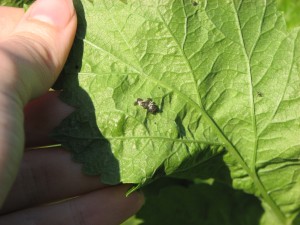
Insect Egg Cluster on Parsnips My daughter’s eagle eyes spotted a cluster of insect eggs on the underside of our parsnip leaves. Many moths and butterflies are laying their eggs right now, so seeing a little white pearl glued to the underside of a leaf isn’t strange.

Unknown Butterfly Egg The parsnips in question are late in the garden; they’ve been in the ground for a while and don’t like the heat so they are stressed. Just as we become sick when stressed, so do plants, and the parsnips are under attack by aphids and ants. Ants feed off of the sticky excretions of the aphids, so they have become ranchers. Ants cultivate herds of aphids on stressed plants, grooming them and collecting their, um, poo. So trying to put that image out of your head, if you see a lot of ants on a plant, expect aphids to be there also. Aphids have rasping, sucking mouthparts that they use to eat away at a plant and suck the vital juices out of it. Sorry, there is another image that you probably don’t want. How to get rid of aphids? The natural way would be to make sure your plants aren’t stressed, and allow ladybugs to flourish in your garden.
So what would you do if you saw THIS in your garden?

Ladybug Larvae Eating Aphids Run screaming? Hit it with a trowel? Wait! You shouldn’t do any of those things! These are baby ladybugs! Just as many children do not resemble the adult into which they will grow, ladybug larvae look like something that Godzilla might take on… if the larvae were the size of a house or something, which they aren’t. Okay, I’m digressing here.
Back to that cluster of eggs my daughter saw. They were hatching ladybug larvae!

Hatching Ladybug Egg Cluster I’ve never seen them that small before. Good news for the garden: rescue forces are being hatched!

Ladybug Larvae Hatching Ladybug larvae eat more aphids than the adults do (just think of teenagers and refrigerators). When they’ve grown as much as they can, they will transform in to the ladybugs that we all know and love (even though we sing a horrible song to them about leaving the garden to check on a false alarm about fire and their children. And people complain about not being able to keep ladybugs in their yards!)

Ladybug! So if you see a creepy bug on your plants, the sides of your house… anywhere… don’t squish him! It may be part of the Ladybug Larvae Special Forces out to break up the illegal ant ranches in your garden!
